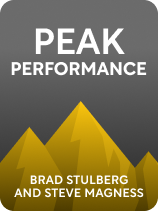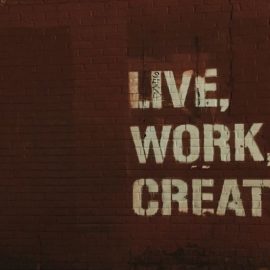

This article is an excerpt from the Shortform book guide to "Peak Performance" by Brad Stulberg and Steve Magness. Shortform has the world's best summaries and analyses of books you should be reading.
Like this article? Sign up for a free trial here.
What’s the book Peak Performance about? Why are humans so vulnerable to exhaustion and burnout?
In Peak Performance, Brad Stulberg and Steve Magness offer a formula for maximizing human performance. This is to help you push beyond your limits and achieve goals that may seem impossible.
Read below for a brief Peak Performance book overview.
Peak Performance by Brad Stulberg and Steve Magness
In virtually every domain—be it corporate jobs, athletic pursuits, or even college admissions—top performers are pushing the boundaries of human possibilities. But this relentless quest for excellence often leaves us suffering from chronic exhaustion and burnout, harming our performance and even our health. In their book Peak Performance, human performance experts Brad Stulberg and Steve Magness attempt to remedy this situation. They argue that sustainable elite performance is possible by implementing cycles of stress and rest.
Seasoned researchers and former elite performers themselves, Stulberg and Magness bring both empirical evidence and personal experience to their writing. Stulberg is a former consultant at the elite McKinsey consulting firm and the author of Master of Change. As such, he’s an expert at distilling his recommendations for growth into accessible prose. Magness is a former world-class youth runner and author of the bestseller Do Hard Things, which discusses the science of resilience for a general audience. As such, he brings his expertise in the physiology of performance to the book.
The Foundation of Growth
According to Stulberg and Magness, achieving maximal performance requires understanding how to grow in the first place. Consequently, they begin by outlining their formula for the type of growth that allows you to harness your potential. In this section, we’ll examine this formula, explaining why growth—whether intellectual or athletic—is a product of alternating between periods of stress and rest. We’ll also examine the authors’ concrete strategies for appropriately straining your body and mind and recovering afterward.
The Two Components of Growth
According to Stulberg and Magness, growth in any domain—mental, physical, or emotional—follows from a uniform formula. This formula holds that alternating between periods of stress and periods of rest yields consistent growth. To show as much, they examine the training of elite athletes and elite creatives to illustrate that it conforms to this formula.
It’s helpful to clarify what Stulberg and Magness mean by stress and rest in the first place. They explain that:
- Stress is a type of stimulus that challenges the body or mind by pushing it near its limits. For example, to accustom their body to marathon pace, a marathon runner might run a series of one-mile intervals at race pace with only small breaks in between.
- Rest is a period of relative inactivity that gives the body or mind time to recuperate from the stressor. In the previous example, the marathon runner might take the next day off, or only go for an easy run, to allow their body time to recover.
Stulberg and Magness point out that this cycle of stress and rest is ubiquitous among elite endurance athletes, according to research comparing the training patterns of elite athletes in various endurance sports, such as swimming, running, cycling, and cross-country skiing. This research found that, instead of continuously performing high-octane exercises every day, these athletes repeatedly alternated between periods of intense exercise and periods of recovery.
But Stulberg and Magness also note that this pattern isn’t limited to athletes. On the contrary, they cite research from Hungarian psychologist Mihaly Csikszentmihalyi (Flow) showing that creative intellectuals embrace this same approach. Csikszentmihalyi interviewed the top intellectuals in various disciplines and found that they largely used the same strategy that athletes use when training: They were either focusing wholeheartedly on their research or taking time away from it to recuperate.
How to Use Stress to Grow
Having shown that a combination of stress and rest is essential for growth, Stulberg and Magness proceed to discuss the optimal way to structure these cycles. In this section, we’ll focus on three of their recommendations for incorporating stress in order to grow: Partake in challenges at the edge of your comfort zone, focus intensely during bouts of stress, and undergo short periods of stress.
Strategy #1: Partake in Challenges at the Edge of Your Comfort Zone
Stulberg and Magness argue that challenges that push us out of our comfort zone—without making us lose control—are a crucial type of stress. According to Csikszentmihalyi, these challenges strike a perfect balance between stress that’s too strenuous and stress that’s not strenuous enough. Tasks that are too easy, Stulberg and Magness point out, aren’t challenging enough to stimulate growth, while tasks that are too difficult prevent us from focusing and thus hinder our growth.
Strategy #2: Focus Intensely During Stress
Stulberg and Magness report that experiments from behavioral scientist K. Anders Ericsson confirm that intense focus is essential to optimize our training. For instance, in one experiment, Ericsson examined the practice schedules of expert violinists at the Global Music Academy in Berlin. He found that, though all the violinists practiced for roughly the same amount of time, they spent that time differently—the truly elite violinists practiced with singular focus, whereas the more “average” violinists tended to practice inefficiently because of distractions.
Strategy #3: Use Short Periods of Stress
Stulberg and Magness emphasize that periods of focused training shouldn’t last indefinitely. On the contrary, they argue that stress should occur in short periods lasting around an hour. In addition to Ericsson’s own research, which found that top performers generally work in 60- to 90-minute bursts, Stulberg and Magness cite findings from the Draugiem Group, a social networking company that examined its most successful employees. The group found that on average, its best employees spent 52 minutes working intensely before taking a 17-minute break. In a similar vein, Stulberg and Magness report that the most efficient workers in a meat processing plant worked 51 minutes before taking a 9-minute break.
How to Use Rest to Grow
In light of their proposed strategies for harnessing stress, Stulberg and Magness discuss the optimal strategies for the other half of their formula—rest. Although it’s tempting to think of rest as something passive, Stulberg and Magness argue that we should take active steps to rest effectively by practicing mindfulness, prioritizing sleep, and taking short walks.
Strategy #1: Practice Mindfulness
Mindfulness meditation, Stulberg and Magness explain, is a Buddhist form of meditation that involves focusing solely on one’s breathing. By practicing mindfulness when resting, practitioners become better at coping with stress. To show as much, Stulberg and Magness point to studies demonstrating that mindfulness meditation is associated with increased activation in the prefrontal cortex, the part of our brain that controls our stress response. Other studies have found that experienced mindfulness practitioners respond better to pain and discomfort than novices—according to brain scans, experienced practitioners are able to switch off the emotional response to pain in their amygdalas, while novices cannot.
Strategy #2: Prioritize Sleep
According to Stulberg and Magness, sleep is another crucial form of rest for intellectuals and athletes alike. Stulberg and Magness relate that numerous studies have shown that sleep helps us consolidate information—in other words, it reinforces the information that we know and forges connections between new pieces of information. However, they point out that sleep’s key benefits are derived from rapid eye movement (REM) sleep, which largely occurs between hours seven and nine of sleep. Consequently, intellectuals need copious amounts of sleep to reap its full benefits.
Stulberg and Magness also note that, for athletes, sleep is crucial for activating the anabolic state—a state in which hormones like testosterone and human growth hormone flood our bodies and help repair our muscles and bones. These hormones are released during REM sleep, meaning sleep-deprived athletes can enjoy outsized physical benefits simply by sleeping a couple hours longer to spend more time in REM sleep.
Strategy #3: Take Short Walks
Stulberg and Magness argue that taking short walks is an underappreciated form of rest. They note research showing that these walks can spark creative ideas. The researchers separated workers into three groups—one that didn’t go on a walk, one that went on a six-minute walk outdoors, and one that went on a six-minute walk indoors—and had everyone take the same creativity test. Those who walked outdoors and those who walked indoors scored 60% and 40% higher than those who didn’t walk at all, respectively.
Converting Growth Into Performance
While utilizing a consistent cycle of stress and rest sets the foundation for performance by fostering growth, Stulberg and Magness acknowledge that growth alone doesn’t ensure elite performance. For this reason, they offer three additional steps for converting growth into performance: developing a pre-performance routine, intentionally structuring your resources around your goals, and harnessing your purpose.
The Importance of Routine
According to Stulberg and Magness, an essential part of optimal performance in any domain is a consistent pre-performance routine. To craft your own routine, they recommend cultivating a positive mood, incorporating your environment into your routine, and personalizing your routine. ducing additional clutter on your desk to minimize distractions and make yourself more efficient.)
The Importance of Intentionality
In addition to Stulberg and Magness’s recommendation that you intentionally structure your pre-performance routine, they also recommend that you intentionally structure your day-to-day life around your goals. Specifically, they offer the following concrete recommendations for intentionally pursuing your goals: Work in line with your chronotype; surround yourself with those who motivate you, and perform your best every single day.
The Importance of Purpose
Having shown how an optimal routine and daily intentionality are conducive to top performance, Stulberg and Magness argue that one final factor is crucial for exceeding our limits: purpose. They contend that having a purpose that goes beyond our own interests is essential to maximizing performance, because such purposes help us overcome our perceived psychological limitations.
For context, Stulberg and Magness explain that physical fatigue lies not only in our bodies, but also in our minds. To show as much, they cite an experiment that asked weightlifters to perform leg exercises until physical exhaustion—the point at which they could no longer lift. Researchers then ran an electric current through their legs and found that their leg muscles could still contract, suggesting they weren’t truly depleted, even though the weightlifters believed they were.
Because fatigue lies partially in our minds, it stands to reason that if we could shift our perception of fatigue during stress, we could increase our performance. And, Stulberg and Magness report, one study suggests we can do just that. In this study, researchers scanned the brains of participants who were exposed to threats, asking one group to think about their core values beforehand. Those who thought about their values displayed brain activity showing that they perceived the threats positively. In other words, reflecting on their values allowed them to shift the brain’s perception of threats.
For this reason, Stulberg and Magness note that individuals with stronger senses of purpose performed better at their jobs. For example, one study of hospital janitors found that janitors who believed their job was crucial for helping patients heal performed better and were more satisfied than those who lacked this sense of purpose. Further, in a separate meta-analysis of over 200,000 employees, scientists found a significant positive association between increased job performance and employees’ belief that their job positively impacted others.

———End of Preview———
Like what you just read? Read the rest of the world's best book summary and analysis of Brad Stulberg and Steve Magness's "Peak Performance" at Shortform.
Here's what you'll find in our full Peak Performance summary:
- That the quest for excellence leaves us suffering from exhaustion and burnout
- Why cycles of stress and rest are necessary for sustainable elite performance
- How to develop a consistent routine and structure your time






